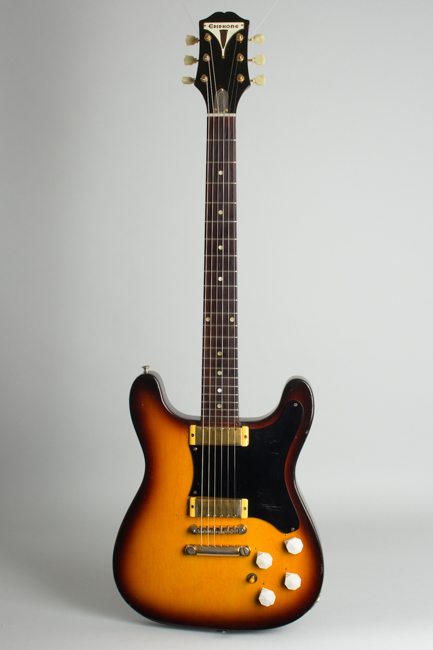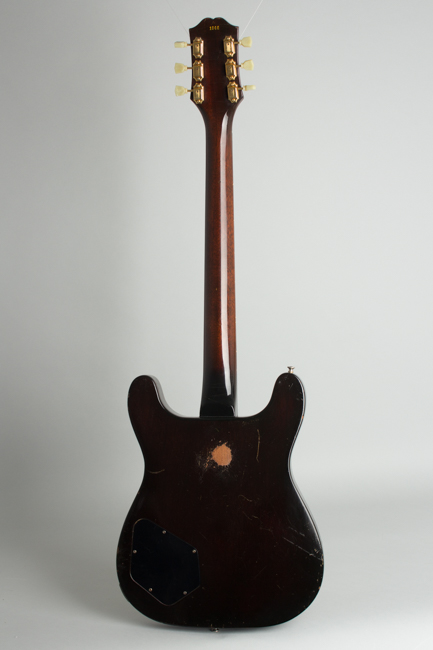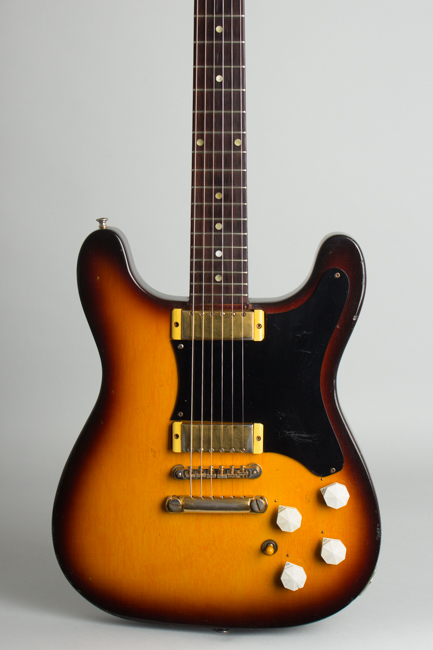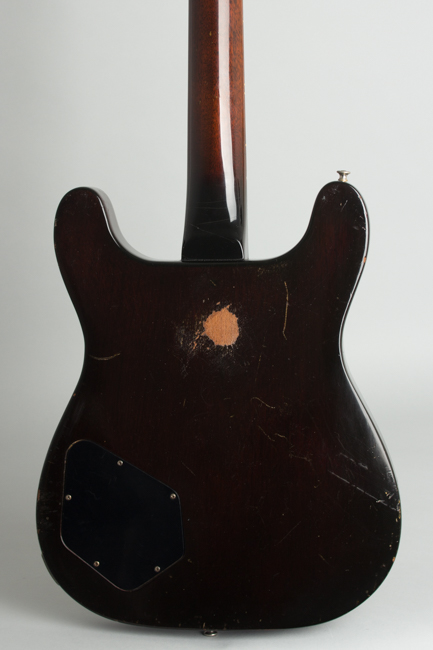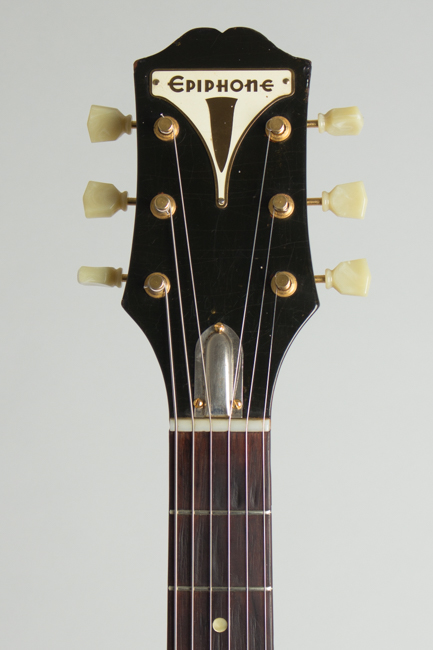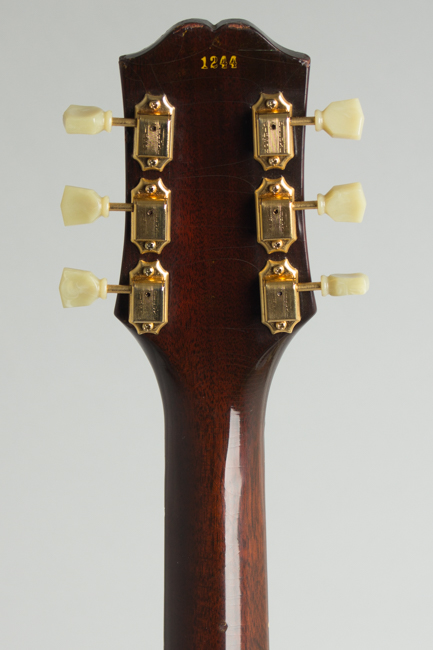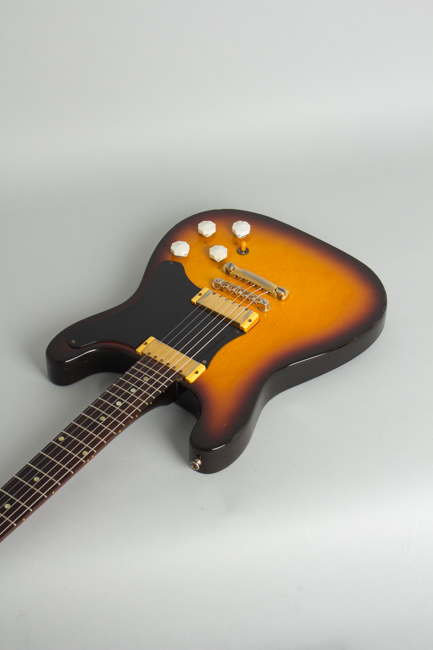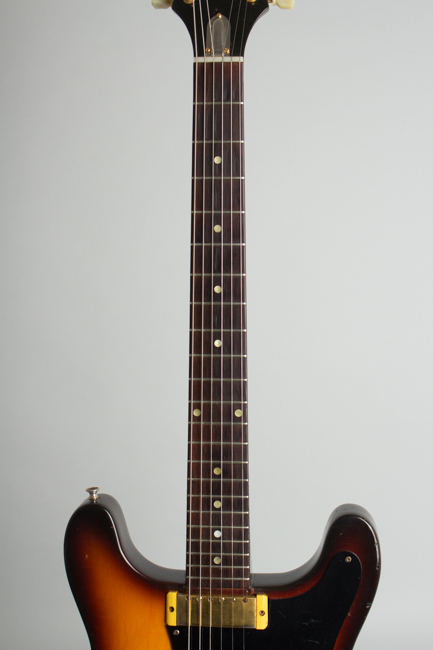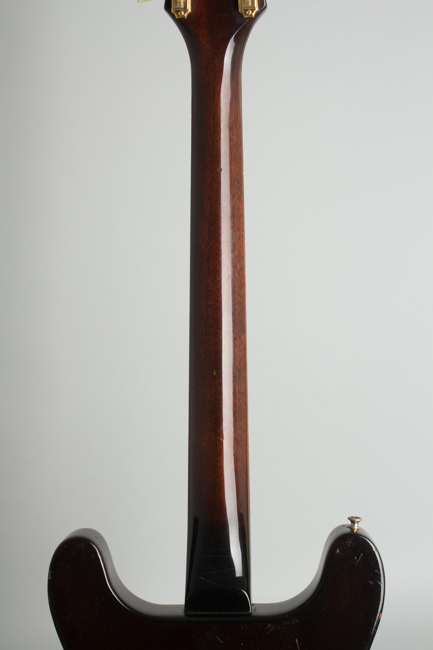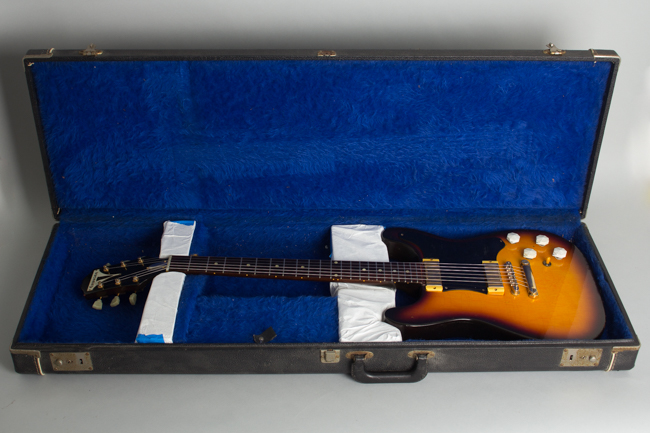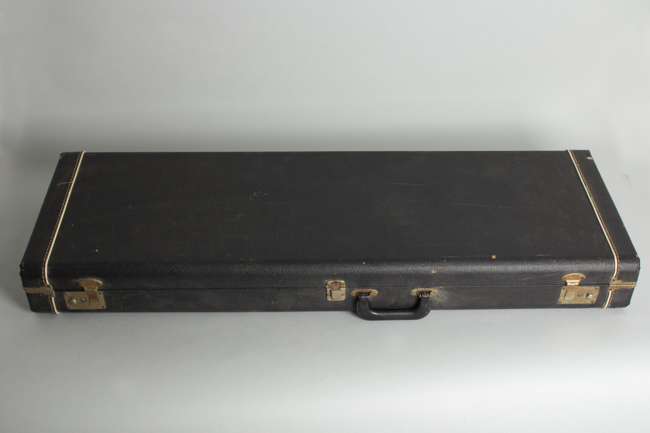Epiphone SB-332 Crestwood Solid Body Electric Guitar (1959)
This item has been sold.
Item # 9274
Prices subject to change without notice.
Epiphone SB-332 Crestwood Model Solid Body Electric Guitar (1959), made in Kalamazoo, Michigan, sunburst top, dark back and sides finish, mahogany bady and neck, rosewood fingerboard, black tolex hard shell case.
This unusual slab-sided solid body guitar is one of the very earliest Epiphone-branded instruments made in Kalamazoo, as Gibson was just re-starting the brand they had purchased in 1957. The first-generation Crestwood is an extremely rare instrument made only from the tail end of 1958 through late 1959 and one of the least well known of all Gibson made solidbodies. Available figures indicate none of these shipped in 1958, all of 43 in 1959 and a further 45 in 1960 which already showed a number of feature changes. Samples of the new Epiphone line were first shown at the July 1958 NAMM show, but orders were scarce and production was slow to get up to speed.
This Crestwood was the Deluxe model of the first two production solidbodies to bear the Epiphone name, alongside the single pickup Coronet. That was a student instrument kin to a Les Paul, Jr, while the Crestwood was the professional model equivalent to the 1959 Les Paul Standard. The instrument has a host of unusual features and does not play or sound like any other Gibson, or indeed any other solidbody from the 1950's or '60's. Epiphone solidbodies were subsequently streamlined in 1960 with contoured bodies and more typically Gibsonesque features, leaving these initial first-year examples as mostly forgotten experimental orphans.
This primal Crestwood is built on a 1 3/4 inch deep slab of mahogany with squared-off edges rather reminiscent of a Telecaster, albeit with a second full cutaway above the neck. It is interesting to note that Gibson appears to have been first experimenting with Fender-like design elements with this second-line brand rather than under their own marque. The otherwise square-sided body has a slight back contour near the upper edge, another subtle nod to Fender that is not found on some examples. The body has a ambered yellow/brown sunburst on the top and dark mahogany back and sides.
The fairly slim mahogany neck has a rather hard V profile unlike anything Gibson was doing in the late 1950's may actually be an old Epiphone archtop blank from years earlier repurposed. The rosewood fingerboard is dot inlaid and unbound, unusual for Gibson on a higher-end guitar. The neck is fitted with a Gibson truss rod under the old stamped metal Epiphone cover. The headstock had the metal logo plate Epiphone had been using on electrics since the 1930s, with Kluson Deluxe tuners typical of Gibson. The inked-on 4-digit serial number 1244 is odd as well; most have the date-encoded system Gibson used on solid bodies in 1958-9, but this one appears to be part of a distinct A-series started for the new semi-acoustic Epiphones, but missing the 'A'.
The hardware is a mix of original New York Epiphone and stock Gibson fittings. The older Epiphone parts sent up to Kalamazoo were used on these new models as long as they lasted. Gold plated hardware unusual for a mid-line instrument; it may be that a large proportion of the pickups inherited from Epiphone were already gold, so the guitar was designed to help use them up! These "New York" pickups have a unique sound, brighter than anything from Gibson with a snarly edge. As Epiphone had never made any solid body instruments the only place they appear on one is with these first Kalamazoo Crestwoods and Coronets.
The standard Gibson 4-knob, one switch electronics rig shows a visible pot date to the 50th week of 1957 and includes the large 'bumblebee' tone caps much beloved of Les Paul aficionados. It is topped off with white pointer knobs, of a type used by Epiphone since the 1940's. The gold-plated Tune-O-Matic bridge and tailpiece were the same fittings found on the Les Paul Custom. A rather Telecaster-like single-layer black pickguard is fitted that for some unknown reason was factory painted gold on the underside. A small plastic plate is set between the neck pickup and end of the fingerboard with 'Crestwood' engraved on it in tiny letters, then lacquered over, resulting in one of the most discreet logos ever applied at Kalamazoo!
The Crestwood listed at $265 in 1960, equivalent in price to a sunburst Les Paul Standard! The entire instrument has a sort of 'feeling your way' aspect about it and it is possible Gibson's management were unsure exactly what the market would be for this 'Non-Gibson' solidbody. In some ways this is as close as Gibson got to making a Telecaster, although of course with a rather different feel and sound. Very few of these first-year Crestwoods exist and they rarely come up for sale, this is the first and only one we have ever had. Most players and even many veteran collectors have never even seen let alone played one of these, and we can report that aside from its sheer rarity is a fantastic sounding and quite unique instrument.
Overall length is 38 in. (96.5 cm.), 13 in. (33 cm.) wide at lower bout, and 1 3/4 in. (4.4 cm.) in depth, measured at side of rim. Scale length is 24 3/4 in. (629 mm.). Width of nut is 1 11/16 in. (43 mm.).
This guitar shows some general wear and tear but remains nearly all original and a very good example of this seldom-seen instrument. The body finish has scuffs, scratches and dings, mostly notably on the squared-off edges. The back shows some belt buckle wear mostly centered in one fairly deep oval spot just below the neck joint. There are some chips to the headstock edges but the back of the neck is relatively clean with a few small dents.
All the hardware is original except the tuners, which are the exact correct style but from a somewhat later period as the stamped covers read 'Gibson Deluxe' instead of 'Kluson Deluxe'. The gold plating has some wear typical of many period instruments, most notably on the tailpiece and bridge. There are some fairly deep scratches to the pickguard face and odd scuffing around the knobs none of which is overly conspicuous.
There is some typical touch-up work around the back of the heel joint, which is relatively inconspicuous except under blacklight examination. These early Crestwoods have a similar neck/body construction to Gibson's first-generation double-cutaway Les Paul Specials and like them have usually required some remedial work in this area. This one also has a small repaired crack in the heel itself on the treble side, which is fully sealed but not finished over and can be felt. Everything is solid and there is no movement in the heel area, but it does exhibit the common results of a design weakness built into the earliest double-cut Gibson solidbodies.
The original fairly thin frets show only minor wear and the guitar plays very well, with the bridge fully lowered the action is a comfortable 2/32" treble and 3/32" bass. The combination of the slab mahogany body and single-coil Epiphone pickups produces a rip-roaring sound, very different from the typical Gibson of the period but equally fearsome when cranked up through a small tube amp. Except for a small coterie of dedicated collectors and fans the world pretty much forgot Gibson's first Epiphone branded solidbodies, making them one of the lost lodestones of Gibson lore and a fretted conversation piece bar none. Excellent - Condition.
This unusual slab-sided solid body guitar is one of the very earliest Epiphone-branded instruments made in Kalamazoo, as Gibson was just re-starting the brand they had purchased in 1957. The first-generation Crestwood is an extremely rare instrument made only from the tail end of 1958 through late 1959 and one of the least well known of all Gibson made solidbodies. Available figures indicate none of these shipped in 1958, all of 43 in 1959 and a further 45 in 1960 which already showed a number of feature changes. Samples of the new Epiphone line were first shown at the July 1958 NAMM show, but orders were scarce and production was slow to get up to speed.
This Crestwood was the Deluxe model of the first two production solidbodies to bear the Epiphone name, alongside the single pickup Coronet. That was a student instrument kin to a Les Paul, Jr, while the Crestwood was the professional model equivalent to the 1959 Les Paul Standard. The instrument has a host of unusual features and does not play or sound like any other Gibson, or indeed any other solidbody from the 1950's or '60's. Epiphone solidbodies were subsequently streamlined in 1960 with contoured bodies and more typically Gibsonesque features, leaving these initial first-year examples as mostly forgotten experimental orphans.
This primal Crestwood is built on a 1 3/4 inch deep slab of mahogany with squared-off edges rather reminiscent of a Telecaster, albeit with a second full cutaway above the neck. It is interesting to note that Gibson appears to have been first experimenting with Fender-like design elements with this second-line brand rather than under their own marque. The otherwise square-sided body has a slight back contour near the upper edge, another subtle nod to Fender that is not found on some examples. The body has a ambered yellow/brown sunburst on the top and dark mahogany back and sides.
The fairly slim mahogany neck has a rather hard V profile unlike anything Gibson was doing in the late 1950's may actually be an old Epiphone archtop blank from years earlier repurposed. The rosewood fingerboard is dot inlaid and unbound, unusual for Gibson on a higher-end guitar. The neck is fitted with a Gibson truss rod under the old stamped metal Epiphone cover. The headstock had the metal logo plate Epiphone had been using on electrics since the 1930s, with Kluson Deluxe tuners typical of Gibson. The inked-on 4-digit serial number 1244 is odd as well; most have the date-encoded system Gibson used on solid bodies in 1958-9, but this one appears to be part of a distinct A-series started for the new semi-acoustic Epiphones, but missing the 'A'.
The hardware is a mix of original New York Epiphone and stock Gibson fittings. The older Epiphone parts sent up to Kalamazoo were used on these new models as long as they lasted. Gold plated hardware unusual for a mid-line instrument; it may be that a large proportion of the pickups inherited from Epiphone were already gold, so the guitar was designed to help use them up! These "New York" pickups have a unique sound, brighter than anything from Gibson with a snarly edge. As Epiphone had never made any solid body instruments the only place they appear on one is with these first Kalamazoo Crestwoods and Coronets.
The standard Gibson 4-knob, one switch electronics rig shows a visible pot date to the 50th week of 1957 and includes the large 'bumblebee' tone caps much beloved of Les Paul aficionados. It is topped off with white pointer knobs, of a type used by Epiphone since the 1940's. The gold-plated Tune-O-Matic bridge and tailpiece were the same fittings found on the Les Paul Custom. A rather Telecaster-like single-layer black pickguard is fitted that for some unknown reason was factory painted gold on the underside. A small plastic plate is set between the neck pickup and end of the fingerboard with 'Crestwood' engraved on it in tiny letters, then lacquered over, resulting in one of the most discreet logos ever applied at Kalamazoo!
The Crestwood listed at $265 in 1960, equivalent in price to a sunburst Les Paul Standard! The entire instrument has a sort of 'feeling your way' aspect about it and it is possible Gibson's management were unsure exactly what the market would be for this 'Non-Gibson' solidbody. In some ways this is as close as Gibson got to making a Telecaster, although of course with a rather different feel and sound. Very few of these first-year Crestwoods exist and they rarely come up for sale, this is the first and only one we have ever had. Most players and even many veteran collectors have never even seen let alone played one of these, and we can report that aside from its sheer rarity is a fantastic sounding and quite unique instrument.
Overall length is 38 in. (96.5 cm.), 13 in. (33 cm.) wide at lower bout, and 1 3/4 in. (4.4 cm.) in depth, measured at side of rim. Scale length is 24 3/4 in. (629 mm.). Width of nut is 1 11/16 in. (43 mm.).
This guitar shows some general wear and tear but remains nearly all original and a very good example of this seldom-seen instrument. The body finish has scuffs, scratches and dings, mostly notably on the squared-off edges. The back shows some belt buckle wear mostly centered in one fairly deep oval spot just below the neck joint. There are some chips to the headstock edges but the back of the neck is relatively clean with a few small dents.
All the hardware is original except the tuners, which are the exact correct style but from a somewhat later period as the stamped covers read 'Gibson Deluxe' instead of 'Kluson Deluxe'. The gold plating has some wear typical of many period instruments, most notably on the tailpiece and bridge. There are some fairly deep scratches to the pickguard face and odd scuffing around the knobs none of which is overly conspicuous.
There is some typical touch-up work around the back of the heel joint, which is relatively inconspicuous except under blacklight examination. These early Crestwoods have a similar neck/body construction to Gibson's first-generation double-cutaway Les Paul Specials and like them have usually required some remedial work in this area. This one also has a small repaired crack in the heel itself on the treble side, which is fully sealed but not finished over and can be felt. Everything is solid and there is no movement in the heel area, but it does exhibit the common results of a design weakness built into the earliest double-cut Gibson solidbodies.
The original fairly thin frets show only minor wear and the guitar plays very well, with the bridge fully lowered the action is a comfortable 2/32" treble and 3/32" bass. The combination of the slab mahogany body and single-coil Epiphone pickups produces a rip-roaring sound, very different from the typical Gibson of the period but equally fearsome when cranked up through a small tube amp. Except for a small coterie of dedicated collectors and fans the world pretty much forgot Gibson's first Epiphone branded solidbodies, making them one of the lost lodestones of Gibson lore and a fretted conversation piece bar none. Excellent - Condition.
